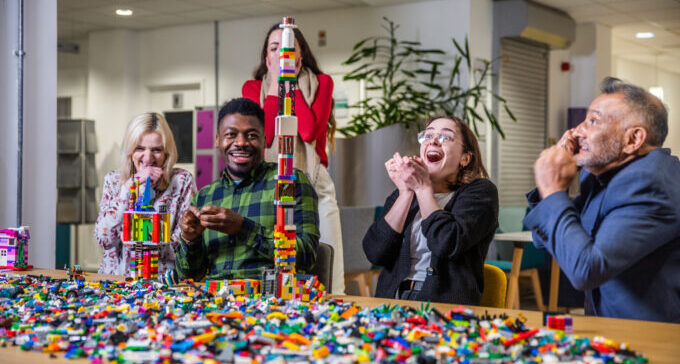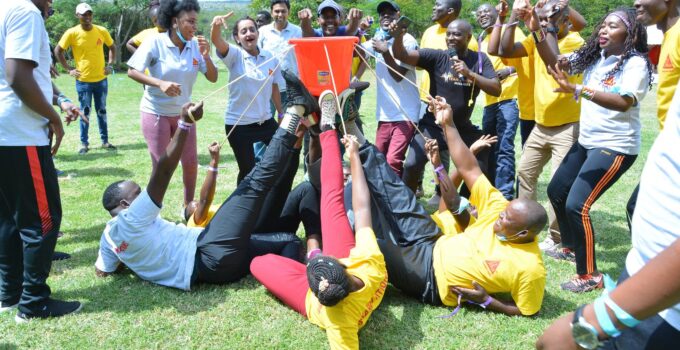Alright, all you business aficionados, gather ’round! Let’s talk team building – but not the snooze-fest kind with trust falls and cringe-worthy icebreakers.
In today’s fast-paced business world, fostering a cohesive team is more crucial than ever. When done right, team-building activities can boost morale, improve communication, and even lead to increased productivity. But here’s the catch: not all activities are created equal.
That’s why I’m here to guide you through the maze of options and help you find the perfect fit for your business. So, grab your hats and join me to discover the perfect team-building treasure for your business!
Assessing Your Team’s Needs
Team Dynamics
Before you start booking that weekend retreat or signing up for a workshop, take a moment to reflect on your team’s current dynamics. Are there any communication gaps? Maybe some unresolved conflicts? By understanding where you stand, you can pinpoint the areas that need a little TLC.
Pro Tip: Regular check-ins can help identify potential issues before they escalate. It’s all about being proactive!
Goals and Objectives

Source: betterteam.com
Now, let’s talk purpose. What do you hope to achieve with these team-building activities? Maybe you’re aiming for better collaboration or perhaps a boost in creativity. Whatever it is, make sure it aligns with your broader business goals. And hey, if you’re in the Brisbane area, there are some fantastic team building activities Brisbane options to explore. From urban farm tours to cocktail making masterclasses, there’s something for every objective.
Identifying Suitable Activities
Outdoor Activities
There’s something refreshing about stepping out of the office and into the great outdoors. Outdoor activities can be exhilarating and offer a change of scenery that can rejuvenate the team. Learn how extreme sports improve team-building activities
Advantages
- Promotes physical activity
- Encourages team bonding in a relaxed environment
Disadvantages:
- Weather-dependent
- Might not be suitable for all members
Examples: Ropes courses can challenge your team and build trust. Scavenger hunts, on the other hand, can be a fun way to encourage collaboration and problem-solving.
Indoor Activities

Source: teambuildinghub.com
If the weather isn’t on your side or you’re looking for something a bit more controlled, indoor activities are the way to go.
Advantages:
- Not weather-dependent
- Can be tailored to specific objectives
Disadvantages:
- Limited physical activity
- Might require special equipment or venue
Examples: Escape rooms can test your team’s problem-solving skills and communication. And if you’re looking for something a bit more laid-back, why not try a DIY terrarium and mindfulness workshop?
Skill-Building Workshops
These are less about fun and more about growth. Workshops can be a great way to upskill your team and address specific areas of improvement.
Advantages:
- Targeted learning
- Can lead to tangible improvements in performance
Disadvantages:
- Might be seen as “just another training session”
- Requires expert facilitators
Examples: Communication workshops can bridge any existing communication gaps, while leadership training can nurture future leaders within your team.
Volunteer and Community Service

Source: teambuildinghub.com
Giving back to the community can be a rewarding experience for your team.
Advantages:
- Fosters a sense of purpose
- Strengthens bonds through shared values
Disadvantages:
- Might not align with everyone’s interests
- Requires coordination with external organizations
Examples: Participating in charity events can boost morale, while environmental clean-ups can be a way to make a positive impact on your community.
Customizing Activities

Source: bricksmcgee.com
Whether you have a team of 5 or 50, it’s essential to choose activities that cater to your team’s size. For smaller teams, intimate workshops might be the way to go. Larger teams? Consider breaking them into smaller groups for activities like scavenger hunts.
Remember, one size doesn’t fit all. It’s a good idea to survey your members and get their input. This way, you ensure that the activities resonate with everyone and aren’t just top-down decisions.
In today’s globalized world, teams are more diverse than ever. It’s crucial to choose activities that are inclusive and cater to everyone’s needs, backgrounds, and abilities. This not only ensures everyone feels valued but also promotes a culture of respect and understanding.
Pro Tip: Use anonymous surveys to get honest feedback from your team about their preferences.
Measuring Success and Effectiveness
Setting Key Performance Indicators (KPIs)

Source: clearpointstrategy.com
To truly gauge the success of your team-building activities, you need to set clear metrics for success. These KPIs will serve as your compass, guiding you towards your desired outcomes. Whether it’s improved communication, increased collaboration, or enhanced creativity, having tangible metrics will help you measure your progress.
Post-Activity Evaluation
Feedback is gold. After each activity, gather insights from your members. Did they find the activity beneficial? What did they learn? What could be improved? This feedback will not only help you assess the immediate impact but also refine future activities.
Long-term Effects
While immediate feedback is essential, the true test of a team-building activity’s success lies in its long-term effects. Monitor changes in collaboration, communication, and overall productivity in the weeks and months following the activity. This will give you a clearer picture of its lasting impact.
Budgeting and Resource Allocation

Source: linkedin.com
Cost Considerations
While team-building activities are an investment in your team’s growth and cohesion, it’s essential to be mindful of costs. Set a clear budget and explore options that offer the best value for your money. Remember, the most expensive option isn’t always the best!
Time and Resource Management
Time is money, especially in the business world. Allocate specific time slots for team-building activities, ensuring they don’t disrupt crucial business operations. Additionally, ensure you have all the necessary resources and personnel in place to facilitate the activity smoothly.
Pro Tip: Consider integrating team-building activities into regular meetings or training sessions to optimize time.
Conclusion
Choosing the right activities can be a game-changer for your business. It’s not just about fun and games; it’s about fostering a cohesive, collaborative, and high-performing team.
By assessing your team’s needs, exploring various options, customizing activities, and measuring their effectiveness, you set your team up for success. So, go ahead, invest in your team, and watch as they soar to new heights, bringing your business along for the ride!







